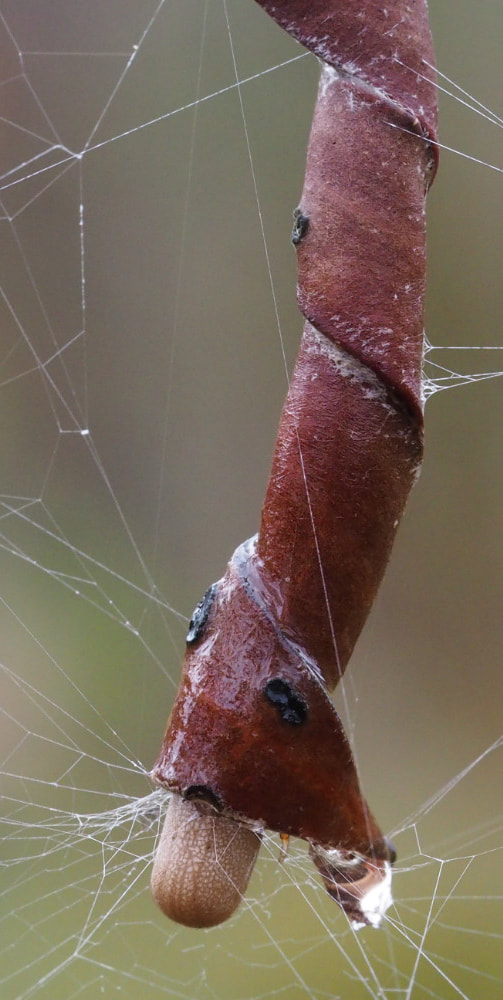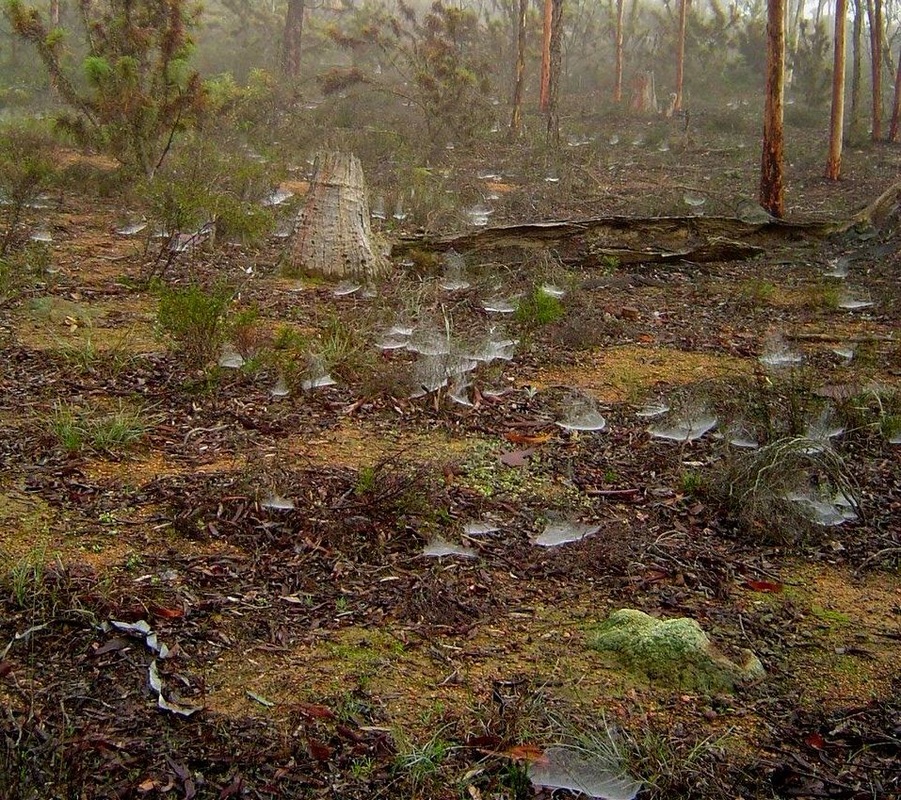| Greetings fellow Foxies, In late spring I noticed a large number of orb shape (circular) spider webs, each with single dead leaf. After noticing that the leaf was always curled in the centre of the web the penny dropped. This belongs to the Leaf Curling Spider Phonognatha graeffei, an orb weaver (i.e. makes a symmetrical web) of the Tetraghaphidae family. These spiders are most common in summer and they are found in southern areas of Australia. They construct a part-orb web and then drag up a live leaf, and curl it. The web-lined leaf conceals the spider during the day but at night the spider leaves its shelter to consume prey that has become entangled in the web. They are amazing engineers, which can lift leaves up to four times their weight. I inadvertently brought a curled leaf back home in the brim of my hat, and noticed it when the owner constructed a hatty web. Aha, recognising a chance to photograph web-making in action, I put the leaf with spider next to a little frame with a black background in a shed, and then forgot about it. When I rushed out to find it next morning the leaf had disappeared. I then noticed that the amazing spider had carted its leaf about a metre and a half further up to make a web over my head. During mating, the male spider visits the boundary of the orb web of the female spider. According to another source the male shares a webby leaf with an immature female until she is old enough to mate. Either way,spiderlings emerging from the resultant egg sacs can survive weeks without food. When conditions improve, they spin a long thread of silk on which they are carried away and construct a web. Incidentally, like the vast majority of spiders, they are no problem for humans. If you could corner one and it bit you, you would suffer no more than temporary local irritation. Message- please don’t harm our spiders? Leaf Curling Spiders are hugely successful in the bush because they are well protected from birds, but I have never seen one in a back yard where Daddy Long Legs reign. More on why later. |
|
2 Comments
Greetings fellow Foxies, Kleptoparasitic spiders are tiny Argyrodes genus (tangle web group) spiders that live in larger spider webs and steal from them. They do this this by creeping up and feeding on wrapped prey along with the host, taking prey too small for the host, or by eating the host’s web. Occasionally they even attack their host. This week for the first time I saw a golden orb weaver Nephila edulis in its golden web above and spanning a driving track in Foxes Lair. At great risk I erected my largest ladder on the ute tray and teetered on the top rung to get the image below. Sure enough, the 5cm beauty was accompanied by a tiny speck Argyrodes antipodianus the kleptoparasitic Dewdrop Spider. If you walk in open bushland on a frosty morning you may be surprised at the multiplicity of “fairy” webs on the ground. In dry weather they are very hard to see until looking into the sun, you can see that each sedge plant has a webby inhabitant. I noticed that several of these webs had 2 totally different size and shape spiders. This time the host was an orb weaver Cyrtophera hirta tent spider with a weird Stick Spider Argyrodes gracilis hemiparasite  Male spider with spoon-shaped palps Male spider with spoon-shaped palps However to confuse matters, orb weaver and tangle web spiders males are also much smaller than the females, and may be a different shape. When Alan Kerrigan and I were on a kleptoparasite photo shoot an insect flew into an adjoining sedge web and was quickly wrapped up by the resident spider. On examining Alan’s images of this later, I was surprised to see that the spider was quite different to that in the adjoining plant. It was a Theriidae family, Archaerena species tangle web spider) and the little one was its male mate. The poor little fellow is likely to be his wife’s dinner whether or not he can do the deed. Even then the deed itself appears to be less than exciting! If you look at the image on the left, you can see that the male has spoon-shaped ends on his palps (short for pedipalps or short front leg-like things) that he fills with sperm and transfers to the female’s genital opening.  Greetings fellow Foxies, Last month I noticed a strange little spider in an orb (“typical” vertical circular) web that had a long lumpy abdomen containing 2 lobes. Genus Cyclosa of the orb weaving Areneidae family is also called the Garbage Line Spider because they have radial lines of thickened silk that contains the remains of their prey with the spider hidden in the line in the centre of the web. Perhaps the spider’s lumpy shape helps it to look like the other detritus. Another name is conical spider. As an aside, I have an aversion to the original Aussie word rubbish being replaced by Yankee garbage but the internet is subverting our language. I just hope that the next generation won’t be toting assault rifles to protect them from themselves! You can see the shed exoskeleton that was left from a recent moult |
Author
Doug Sawkins is a friend of Foxes Lair Categories
All
|













